Thoughts are too loud again, so I write.
Last active 2 hours ago
Don't wanna be here? Send us removal request.
Text
anyway you should always remember that all those foreigners you see dying on the news are just as real people as you are who have just as much interiority as you do. there is nothing about you that makes you more important and it is by pure chance that you are not in their position. in fact, this holds for all of history. every person, no matter the horror of the fate that befell them, had just as much interiority as you do. i feel like some people haven't fully internalized this.
45K notes
·
View notes
Text
Nothing will dispell the "the curtains were just blue" myth faster than writing something yourself, because the amount of pretentious symbolism i am putting in my silly little fanfics is ridiculous. I mean SO much with these words, literally every single one of them. This fic has twenty five typos and zero correct uses of punctuation but if there's curtains you bet your ass I put thought into what colour they were.
22K notes
·
View notes
Text
The symbolism of flowers
Flowers have a long history of symbolism that you can incorporate into your writing to give subtext.
Symbolism varies between cultures and customs, and these particular examples come from Victorian Era Britain. You'll find examples of this symbolism in many well-known novels of the era!
Amaryllis: Pride
Black-eyed Susan: Justice
Bluebell: Humility
Calla Lily: Beauty
Pink Camellia: Longing
Carnations: Female love
Yellow Carnation: Rejection
Clematis: Mental beauty
Columbine: Foolishness
Cyclamen: Resignation
Daffodil: Unrivalled love
Daisy: Innocence, loyalty
Forget-me-not: True love
Gardenia: Secret love
Geranium: Folly, stupidity
Gladiolus: Integrity, strength
Hibiscus: Delicate beauty
Honeysuckle: Bonds of love
Blue Hyacinth: Constancy
Hydrangea: Frigid, heartless
Iris: Faith, trust, wisdom
White Jasmine: Amiability
Lavender: Distrust
Lilac: Joy of youth
White Lily: Purity
Orange Lily: Hatred
Tiger Lily: Wealth, pride
Lily-of-the-valley: Sweetness, humility
Lotus: Enlightenment, rebirth
Magnolia: Nobility
Marigold: Grief, jealousy
Morning Glory: Affection
Nasturtium: Patriotism, conquest
Pansy: Thoughtfulness
Peony: Bashfulness, shame
Poppy: Consolation
Red Rose: Love
Yellow Rose: Jealously, infidelity
Snapdragon: Deception, grace
Sunflower: Adoration
Sweet Willian: Gallantry
Red Tulip: Passion
Violet: Watchfulness, modesty
Yarrow: Everlasting love
Zinnia: Absent, affection
61K notes
·
View notes
Text
20 Ways to Show Extreme Fear in Your Writing
As I dive into researching signs of fear for my horror WIP, I wanted to share some of the most compelling and visceral reactions I’ve come across. Whether you’re writing a chilling scene or crafting a character’s panic, these 20 signs of fear can help bring tension and realism to your story.
Physical Reactions
Hyperventilating — sucking in air but never feeling like it’s enough
Chest tightens — feels like a weight or hands pressing down
Limbs shaking violently, knees buckling
Complete loss of muscle control — collapsing or unable to stand
Cold sweat soaking through clothes
Heart hammering so hard they feel it in their throat or head
Tunnel vision — the world narrowing down to one terrifying focal point
Ringing in the ears or sudden deafness, like the world drops away
Dizziness / feeling faint / vision blurring
Dry mouth — unable to speak or even scream
Uncontrollable Behavior
Screaming / sobbing / gasping — involuntary vocal outbursts
Panic run — bolting without thinking, tripping over everything
Clawing at their own skin / chest / throat — like trying to escape their body
Begging / pleading out loud even if no one’s there
Repeating words or phrases — “No, no, no” / “This isn’t happening”
Hiding instinctively — diving under tables, closets, or corners
Desperate grabbing — reaching for someone, anything solid
Loss of bladder or bowel control (for extreme terror)
Total mental shutdown — frozen, slack-jawed, staring blankly
Memory blackout — later can’t recall what happened during the worst moment
11K notes
·
View notes
Text
How to write hospital scenes
From someone who’s definitely been in too many and would very much like a refund...ツ
⊹ Waiting rooms are emotional purgatory. They’re too bright, too quiet, and weirdly timeless. Fluorescent lights buzzing, TVs playing muted news no one watches, coffee that tastes like burnt stress. People aren’t relaxing in there, they’re just existing, awkwardly pretending their phones are interesting while dissociating at 40% battery.
⊹ Everyone talks in a whisper, but not because it’s respectful, no, it just feels wrong to speak normally. Like the walls might be listening, like if you talk too loud, something worse might happen, even the loud people get quiet in hospitals.
⊹ Overnight stays are hell. hospital chairs? medieval torture devices with upholstery. even if someone’s trying to nap next to a patient, they’re not sleeping. They’re half-listening to the symphony of beeping machines, nurse shoes squeaking, the occasional cough, and distant Code Something crackling over the intercom. it’s anxiety with a blanket.
⊹ The smell is unforgettable, like it’s not just antiseptic. it’s plastic and cafeteria meatloaf and sweat and fear and the smell of a place where people are very much not okay. the first time your character walks in, it’ll hit them like a wall. later, they might not even notice, or maybe it’s the only thing they can smell for days after.
⊹ Talking to doctors is a weird performance. You're trying to be calm, they’re trying to be calm. But no one is calm, your character wants to ask 47 questions and not sound desperate. The doctor explains things like they’re narrating a science video, and when they leave, someone will immediately go “wait... we forgot to ask” every. single. time.
⊹ Monitors beep constantly. half the time, it’s nothing. A wire got loose, someone rolled over. But the second it is something, the vibe shifts fast. Nurses appear like ghosts, machines start going off, and everyone starts moving. And your character? they might freeze, or panic, or forget they have lungs. Go with whatever makes sense for them, but make it visceral.
⊹ Time goes full funhouse mirror. Ten minutes waiting for test results feels like a year. A full hour stretches into eternity, meanwhile, three hours can pass without anyone realizing it. You can use this in your pacing, make it drag when the waiting is unbearable.
⊹ Hospital cafeteria food: Garbage. It’s either offensively bland or stupidly overpriced. The grilled cheese is six dollars and tastes like regret, and someone will 100% cry into a cold sandwich at 3am, because grief doesn’t care where you are.
⊹ People start fixating on tiny, random things. They can’t control the big stuff, so their brain zeroes in on a sock slipping off, a crooked IV pole, the repetitive drip-drip-drip of medication. Let them obsess over something small, it’s how the brain copes with being completely powerless...
3K notes
·
View notes
Text
Children of The River - frames and thoughts
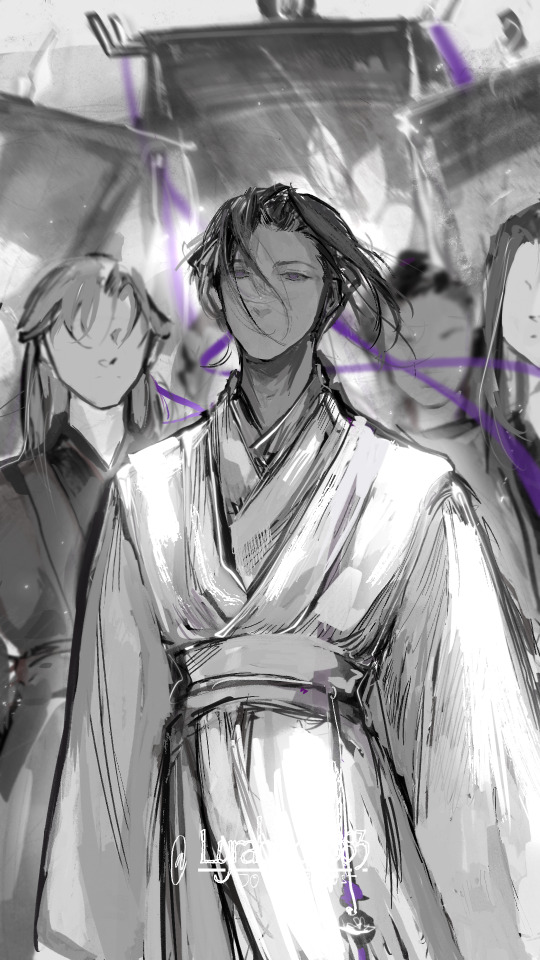
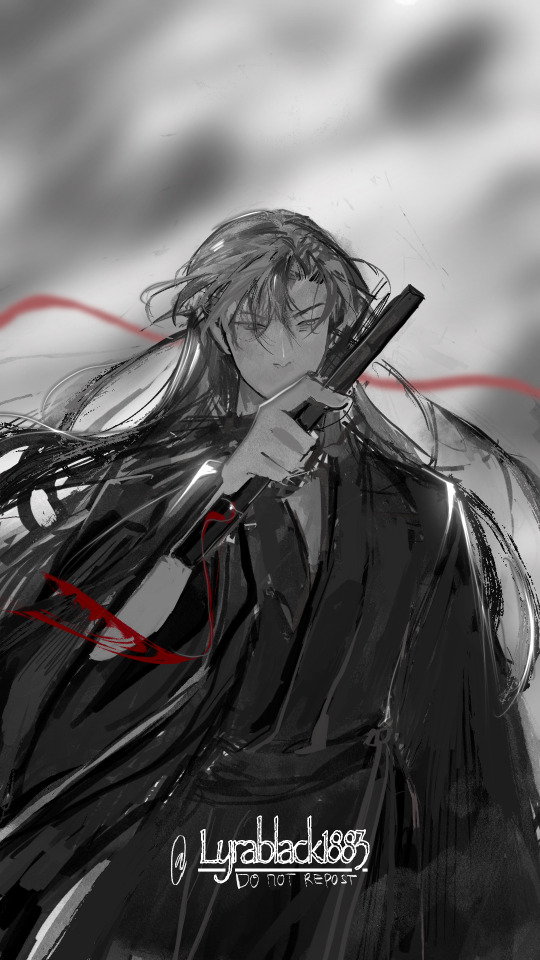
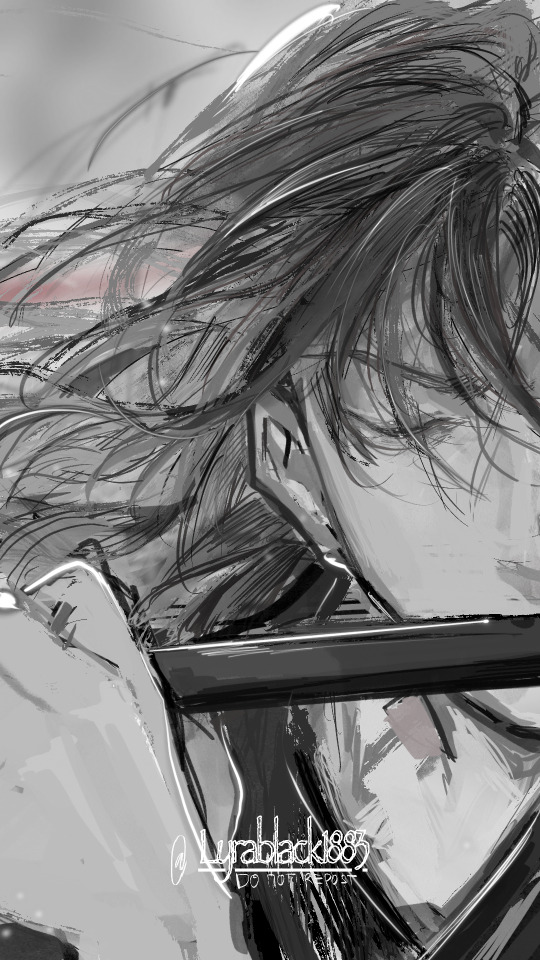
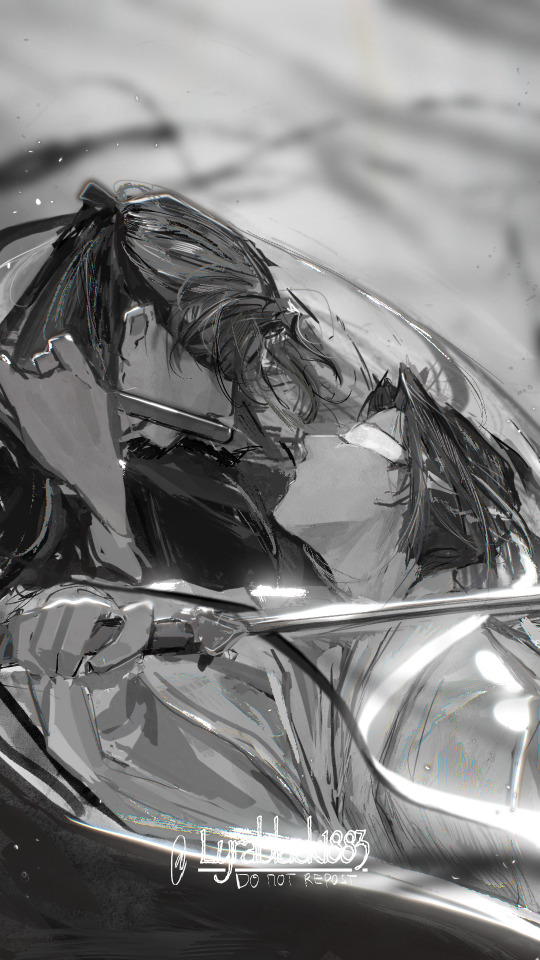
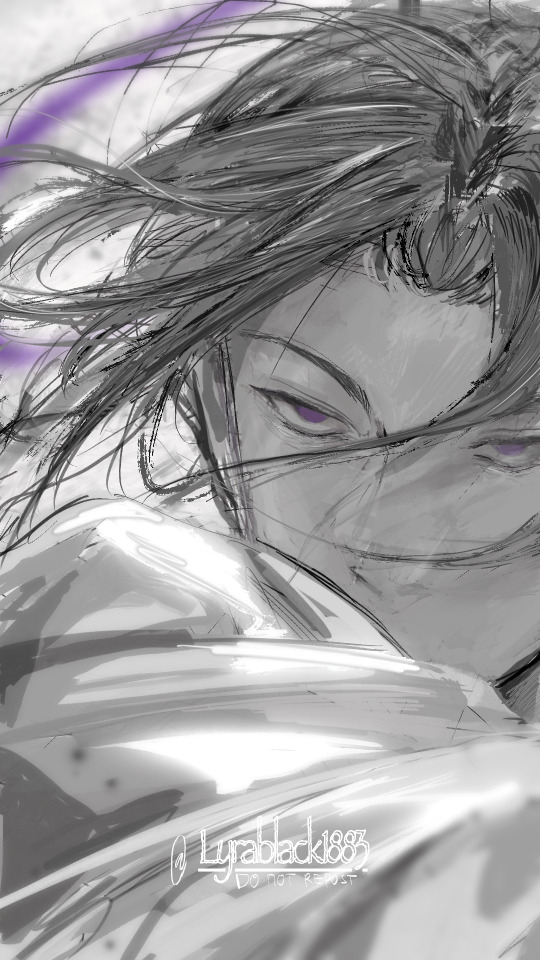
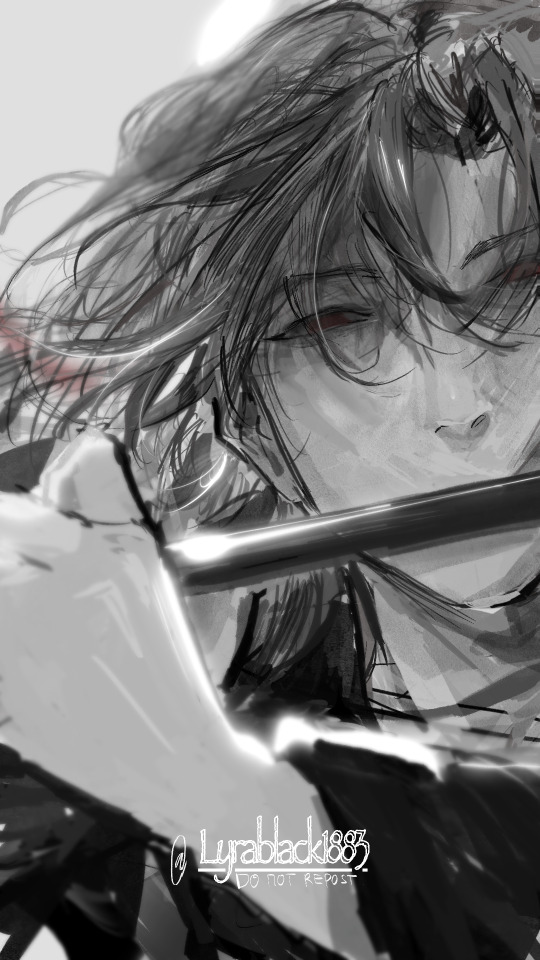
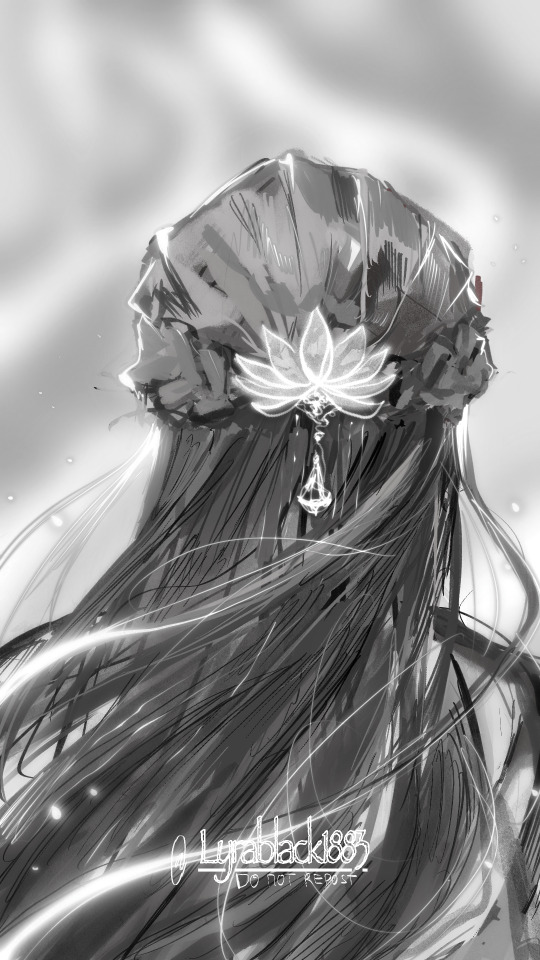
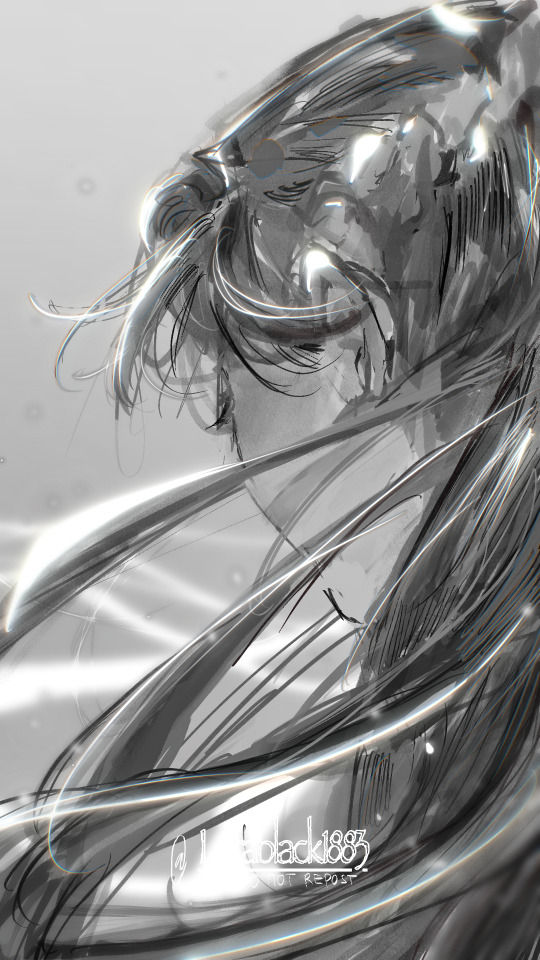
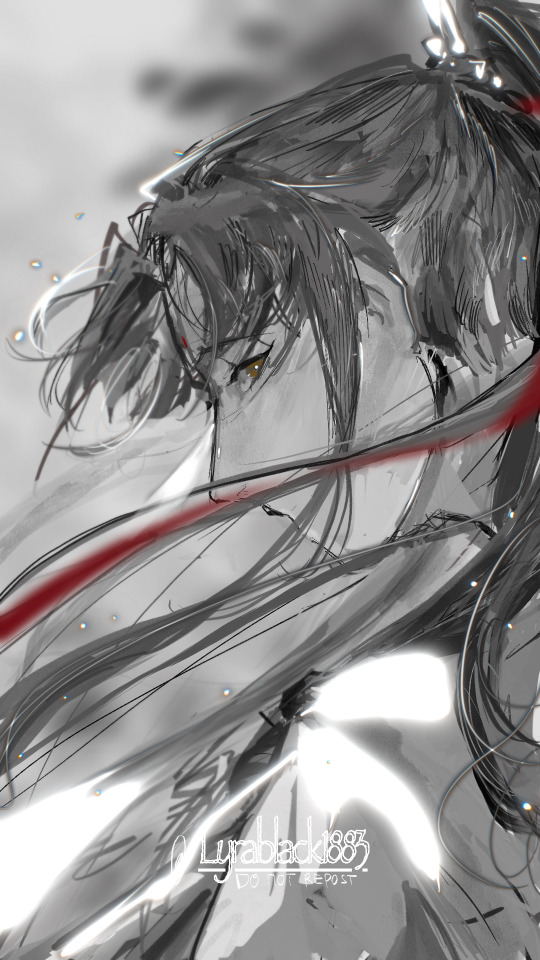
This one has a really messy thought process.
Jiang Cheng’s mourning clothes were intentional. The siege happened only three months after Yanli’s death—not even a hundred days had passed. He was still in mourning. No guan, no Zidian. Just Sandu and his clarity bell.
I wanted, later on to portray that one moment in battle where Jiang Cheng’s figure would mirror Yanli’s. Just for a second. Despite all their differences. The song was picked entirely for the line ‘I’m the river’s daughter’. It ties back to their childhood—the three of them children of Yunmeng Jiang. ‘Jiang’ means river, so it felt fitting. Too fitting, honestly.
⸻
When I drew their expressions, there was one emotion I wanted to show most. Most depictions of the siege go straight into revenge, fury, rage. But for these two? I didn’t want anger to be the main thing. I wanted to show grief.
That kind of hollowing, simmering grief that sits in your chest and never leaves. Especially with Wei Wuxian—it’s complicated. You can feel how hard he’s trying to keep it together. To stay calm. To control it. And then you see it—red bleeding into his eyes. For Jiang cheng, There’s that one line where Wei wuxian describes Jiang Cheng’s face as full of hostility… but also incredibly gloomy. I just went on with it.
⸻
The blindfolded panel was very much on purpose—a way to show how both of them were just pieces in someone else’s game. A center piece of this animatic, you could say. One small detail is I made Jiang Cheng’s sword point toward his own neck. Just a hint. A quiet suggestion. That start with one truth —Jiang Cheng could never have won against Wei Wuxian. And at the same time, Wei Wuxian could never let Jiang Cheng die.
To be blunt, Yunmeng Jiang was weak at that point. They were barely standing. The sect had been rebuilt, yes, but it hadn’t even been five years. They’d lost so much. You can see it in how little they received after the Wen war—basically scraps. Their strength was gone. What kind of people were crazy enough to follow Yunmeng Jiang back then— to stand behind a leader who held a single flag alone in the middle of a war?
Probably the kind who had nothing left.
The kind who’d already lost the same.
Calling them a major force was more of a political statement than reality. they were made into a shield. Something to take the hit. Something to use.
⸻
Why make Yunmeng Jiang the main force in the first place?
A sect barely standing, rebuilt on ashes, carrying grief like second skin.
They didn’t have the numbers. They didn’t have the strength.
But they had Jiang Cheng.
And that was enough.
Not because he could win—but because he was the one Wei Wuxian couldn’t kill.
That was the play. That was the advantage.
They made him a commander, not out of honor—but because he was the only sword that could get close without being struck down.
The only one who could hold that line while the rest moved in for the kill.
They handed him the siege—
because they knew he’d walk straight into the fire, and Wei Wuxian would flinch.
⸻
The cultivation world had witness something. They saw what happened in Nightless City. They saw the two of them face each other—and how Wei Wuxian let Jiang Cheng live. And they made their bet.
Not just on strength or strategy. They bet on history. On loyalty. On love—if you want to call it that. Not romantic, but something deeper. Something messy. The love that comes from being raised together, losing the same people, breaking and still somehow holding on.
That’s why Jiang Cheng made the perfect shield. Maybe even the perfect knife.
They weren’t just betting on power.
They were betting on love.
And they bet right.
391 notes
·
View notes
Text
Advice for writing relationships
Ship Dynamics
How to create quick chemistry
How to write a polyamorous relationship
How to write a wedding
How to write found family
How to write forbidden love
Introducing partner(s) to family
Honeymoon
Date gone wrong
Fluffy Kiss Scene
Love Language - Showing, not telling
Love Language - Showing you care
Affections without touching
Giving the reader butterflies with your characters
Reasons a couple would divorce on good terms
Reasons for breaking up while still loving each other
Relationship Problems
Relationship Changes
Milestones in a relationship
Platonic activities for friends
Settings for conversations
How to write a love-hate relationship
How to write enemies to lovers
How to write lovers to enemies to lovers
How to write academic rivals to lovers
How to write age difference
Reasons a couple would divorce on good terms
Reasons for having a crush on someone
Ways to sabotage someone else's relationship
Ways a wedding could go wrong
Arranged matrimony for royalty
Signs of a Toxic Relationship
If you like my blog and want to support me, you can buy me a coffee or become a member! And check out my Instagram! 🥰
30K notes
·
View notes
Text
Children of The River
592 notes
·
View notes
Text
💀 Making Your Villain Make Sense (Without Making Them Right™)
("because if I see one more war criminal with a sad diary entry get a redemption arc, I’m gonna throw my laptop.")
Here’s the thing: your villain doesn’t need to be redeemable. But they do need to make sense.
And I mean sense beyond "they’re evil and they monologue about it." Or “they have a tragic past, so now they do murder <3.” Or “they were right all along, the hero just couldn’t see it 🥺.”
Let’s fix that.
─────── ✦ ───────
🧠 STEP ONE: BUILD A LOGIC SYSTEM THAT ISN’T OURS Your villain shouldn’t just be wrong, they should have their own internal system that works for them. Morally flawed? Absolutely. But coherent.
Ask yourself:
What do they value more than anything? (Power? Order? Loyalty? Vengeance?)
What do they believe about the world, and how did they get there?
What fear drives them? What future do they think they’re trying to prevent?
The villain doesn’t need to know they’re wrong. But you should.
Make their logic airtight. even if it’s awful. Give them cause and effect.
─────── ✦ ───────
👿 STEP TWO: STOP GIVING THEM THE BETTER IDEOLOGY Listen. I love a “morally gray” moment as much as anyone. But if your villain is making all the good points and the hero’s just like “no because that’s mean,” your arc is upside down.
If your villain is critiquing injustice, oppression, or inequality, make sure their methods are the problem, not their entire worldview.
✖︎ WRONG: Villain: “The ruling class is corrupt.” Hero: “That’s not nice.”
✔︎ RIGHT: Villain: “The ruling class is corrupt, so I’m burning the city and everyone in it.” Hero: “So you’re just… committing genocide now?”
Your villain can touch a real issue. Just don’t let them be the only one talking about it, or solving it with horror movie logic.
─────── ✦ ───────
🔪 STEP THREE: GIVE THEM POWER THAT COSTS THEM The best villains lose things too. They’re not just untouchable horror dolls in sexy coats. They make bad choices and pay for them. That’s where the drama lives.
Examples:
They isolate themselves.
They sacrifice people they love.
They get what they want, and it destroys them.
They know they’re the monster, and choose it anyway.
If your villain can kill a dozen people and feel nothing, that’s not scary. That’s boring. Let them bleed. Let them regret it. Let them double down anyway.
─────── ✦ ───────
🧱 STEP FOUR: MAKE THEM PART OF THE WORLD, NOT OUTSIDE IT Villains shouldn’t feel like they were patched in from another genre. They should be part of the world’s logic, culture, class system, history. They should reflect something about the setting.
Villains that slap:
The advisor who upheld the regime until they decided they deserved to rule.
The noble who’s using war to reclaim stolen legacy.
The ex-hero who thinks the system can’t be saved, only reset.
The priest who truly believes the gods demand blood.
They’re not just evil, they’re a product of the same world the hero is trying to save.
─────── ✦ ───────
👁 STEP FIVE: SHOW US THEIR SELF-JUSTIFICATION You don’t need a tragic backstory™. But you do need to show us why they think they’re right. Not just with exposition, through action.
Let us watch them:
Protect someone.
Choose their goal over safety.
Justify the unjustifiable to a character who loves them.
Refuse to change, even when given a chance.
A villain who looks into the mirror and goes “Yes. I’m correct.” is 1000x scarier than one who sobs into a journal and says “I’m so broken 🥺.”
─────── ✦ ───────
🧨 BONUS ROUND: DON’T MAKE THEM A HATRED MEGAPHONE Especially if you’re writing marginalized characters: don’t let your villain become a mouthpiece for slurs, abuse, or extremism just to make them “evil enough.” That’s lazy. And harmful.
You don’t need real-world hate speech to build a dark character. You need power, consequence, and intent.
─────── ✦ ───────
TL;DR: Good villains don’t need to be right. They need to be real. Not a vibe. Not a sad boy in a trench coat. Not a trauma monologue and then a sword fight. They need logic. They need cost. They need to scare you because you get them, and still want them to lose.
Make them dangerous. Not relatable. Make them whole. Not wholesome. Make them make sense.
—rin t. // thewriteadviceforwriters // villain critic. final boss consultant. licensed chaos goblin
P.S. I made a free mini eBook about the 5 biggest mistakes writers make in the first 10 pages 👀 you can grab it here for FREE:
2K notes
·
View notes
Text
✏️ Writing Dialogue That Sounds Like Real People, Not Theater Kids on Red Bull
(a crash course in vibes, verbal economy, and making your characters shut up already)
Okay. We need to talk about dialogue. Specifically: why everyone in your draft sounds like they’re in a high school improv group doing a dramatic reading of Riverdale fanfiction.
Before you panic, this is normal. Early dialogue is almost always too much. Too polished. Too "scripted." So if yours feels off? You’re not failing. You’re just doing Draft Zero Dialogue, and it’s time to revise it like a boss.
Here’s how to fix it.
─────── ✦ ───────
🎭 STEP ONE: DETOX THEATER ENERGY I say this with love: your characters are not all quippy geniuses. They do not need to deliver emotional monologues at every plot beat. They can just say things. Weird, half-finished, awkward things.
Real people:
interrupt each other
trail off mid-thought
dodge questions
contradict themselves
repeat stuff
change the subject randomly
Let your characters sound messy. Not every line needs to sparkle. In fact, the more effort you put into making dialogue ✨perfect✨, the more fake it sounds. Cut 30% of your clever lines and see what happens.
─────── ✦ ───────
🎤 STEP TWO: GIVE EACH CHARACTER A VERBAL FINGERPRINT The fastest way to make dialogue feel alive? Make everyone speak differently. Think rhythm, grammar, vocabulary, tone.
Some dials you can twist:
Long-winded vs. clipped
Formal vs. casual
Emojis of speech: sarcasm, filler words, expletives, slang
Sentence structure: do they talk in fragments? Run-ons? Spirals?
Emotion control: are they blunt, diplomatic, avoidant, performative?
Here’s a shortcut: imagine what your character sounds like over text. Are they the “lol okay” type or the “okie dokie artichokie 🌈✨” one? Now translate that into speech.
─────── ✦ ───────
🧠 STEP THREE: FUNCTION > FILLER Every line of dialogue should do something. Reveal something. Move something. Change something.
Ask:
Does this line push the plot forward?
Does it show character motivation/conflict/dynamic?
Does it create tension, add context, or raise a question?
If it’s just noise? It’s dead air. Cut it. Replace it with a glance. A gesture. A silence that says more.
TIP: look at a dialogue scene and remove every third line. Does the scene still work? Probably better.
─────── ✦ ───────
💥 STEP FOUR: REACTIVITY IS THE GOLD STANDARD Characters don’t talk into a void. They respond. And how they respond = the real juice.
Don’t just write back-and-forth ping pong. Write conflict, dodge, misunderstanding. If one character says something vulnerable, the other might joke. Or ignore it. Or say something cruel. That’s tension.
Dialogue is not just information exchange. It’s emotional strategy.
Try this exercise: A says something revealing. B lies. A notices, but pretends they don’t. B changes the subject. Now you’ve got a real scene.
─────── ✦ ───────
🔍 STEP FIVE: PAY ATTENTION TO POWER Every convo has a power dynamic, even if it’s tiny. Who’s steering? Who’s withholding? Who’s deflecting, chasing, challenging?
Power can shift line to line. That shift = tension. And tension = narrative fuel.
Write conversations like chess matches, not ping pong.
─────── ✦ ───────
✂️ STEP SIX: SCISSORS ARE YOUR BEST FRIEND The best dialogue is often the second draft. Or third. Or fourth. First drafts are just you figuring out what everyone wants to say. Later drafts figure out what they actually would say.
Things to cut:
Greetings/closings ("Hi!" "Bye!"--skip it unless it serves tone)
Exposition disguised as chat
Obvious thoughts spoken aloud
Explaining jokes
Repeating what we already know
Readers are smart. Let them fill in blanks.
─────── ✦ ───────
🎧 STEP SEVEN: READ IT OUT LOUD (YES, REALLY) If you hate this step: too bad. It works. Read it. Mumbling is fine. Cringe is part of the ritual.
Ask yourself:
Would someone actually say this?
Does this sound like one person speaking, or a puppet show with one hand?
Where does the rhythm trip? Where’s the breath?
If you can’t say it out loud without wincing, the reader won’t make it either. Respect the vibe.
─────── ✦ ───────
🏁 TL;DR: If you want your dialogue to sound like real people, let your characters be real. Messy. Annoying. Human. Let them interrupt and lie and joke badly and say the wrong thing at the worst time.
Cut the improv class energy. Kill the urge to be ✨brilliant✨. And listen to how people talk when they’re scared, tired, pissed off, in love, or trying not to say what they mean.
That’s where the good stuff is.
—rin t. // thewriteadviceforwriters // official advocate of awkward silences and one-word replies
P.S. I made a free mini eBook about the 5 biggest mistakes writers make in the first 10 pages 👀 you can grab it here for FREE:
2K notes
·
View notes
Text
Advice for writing relationships
Ship Dynamics
How to create quick chemistry
How to write a polyamorous relationship
How to write a wedding
How to write found family
How to write forbidden love
Introducing partner(s) to family
Honeymoon
Date gone wrong
Fluffy Kiss Scene
Love Language - Showing, not telling
Love Language - Showing you care
Affections without touching
Giving the reader butterflies with your characters
Reasons a couple would divorce on good terms
Reasons for breaking up while still loving each other
Relationship Problems
Relationship Changes
Milestones in a relationship
Platonic activities for friends
Settings for conversations
How to write a love-hate relationship
How to write enemies to lovers
How to write lovers to enemies to lovers
How to write academic rivals to lovers
How to write age difference
Reasons a couple would divorce on good terms
Reasons for having a crush on someone
Ways to sabotage someone else's relationship
Ways a wedding could go wrong
Arranged matrimony for royalty
Signs of a Toxic Relationship
If you like my blog and want to support me, you can buy me a coffee or become a member! And check out my Instagram! 🥰
30K notes
·
View notes
Text
✨ HOW TO ACTUALLY START A BOOK

(no ✨vibes✨, just structure, stakes, and first-sentence sweat)
hello writer friends 💌 so you opened a doc. you sat down. you cracked your knuckles. maybe you even made a playlist or moodboard. and then… you stared at the blinking cursor like it personally insulted your entire bloodline.
here’s your intervention. this post is for when you want to write chapter one, but all you have is aesthetic, maybe a plot bunny, maybe a world idea, maybe nothing at all. here’s how to actually start a book, from structure to sentence one.
—
🌶️ STEP 1: THE SPICE BASE ~ “WHAT’S CHANGING?”
start with this question:
what changes in the protagonist’s life in the first 5–10 pages?
doesn’t have to be earth-shattering. they could get a letter, lose a job, run late, break a rule, wake up hungover in the wrong house. what matters is disruption. the opening of your book should mark a shift. if their day starts normal, it shouldn’t end that way.
🏁 opening chapters are about motion. forward movement. tension. momentum. if nothing is changing, your story isn’t starting, you’re just doing a prequel.
—
⚙️ STEP 2: THE CRUNCHY BITS - CHOOSE AN ENTRY POINT
there are 3 classic places to start a novel. each one works if you’re intentional:
The Day Everything Changes most popular. you drop us in right before or during the inciting incident. clean, fast, efficient.
pro: immediate stakes con: harder to sneak in worldbuilding or character grounding
The Calm Before the Storm starts slightly earlier. show the character’s “normal” life, then break it. useful if the change won’t make sense without context.
pro: space to introduce your character’s routine/flaws con: risky if it drags or feels like setup
The Aftermath drop us in after the big event and fill in gaps as we go. works well for thrillers, mysteries, or emotionally heavy plots.
pro: instant drama con: requires precision to avoid confusion
📝 pick one. commit. don’t blend them or you’ll write three intros at once and cry.
—
🧠 STEP 3: CHARACTER FIRST, ALWAYS
readers don’t care about your setting, your magic system, or your cool mafia politics unless they’re anchored in someone.
in the first scene, we need to know:
what this person wants
what’s bothering them (externally or internally)
one trait they lead with (bold, anxious, calculating, naive, etc.)
that’s it. just one want, one tension, one vibe. no bios. no monologues. no “they weren’t like other girls” essays. put them in a situation and show how they act.
—
⛓️ STEP 4: OPEN WITH FRICTION
first scenes should create questions, not answer them.
there should be tension between:
what the character wants vs. what they’re getting
what’s happening vs. what they expected
what’s being said vs. what’s being felt
you don’t need a gunshot or a car crash (unless you want one). you need conflict. tension = momentum = readers keep reading.
—
✏️ STEP 5: WRITE THE FIRST SENTENCE - THEN IGNORE IT
okay. now you write it.
no pressure. you’re not tattooing it on your soul. this isn’t the final line on the final page. you just need something.
tricks that work:
start in the middle of an action
start with a contradiction
start with something unexpected, funny, or sharp
start with a small lie or a weird detail
💬 examples:
“The body was exactly where she’d left it - rude.” “He was already two hours late to his own kidnapping.” “There was blood on the welcome mat. Again.” “They said don’t open the door. She opened it anyway.”
once you’ve got it? keep going. don’t revise yet. don’t edit. just build momentum.
you can come back and make it ✨iconic✨ later.
—
📦 BONUS: WHAT NOT TO DO IN YOUR OPENING
don’t start with a dream
don’t info-dump lore in paragraph one
don’t give me three pages of your OC making toast
don’t try to sound like a Victorian cryptid unless it’s on purpose
don’t introduce 7 named characters in one scene
don’t start with a quote unless you are 800% sure it slaps
be weird. be sharp. be specific. aim for interest, not perfection.
—
🏁 TL;DR (but make it ✨useful✨)
something in your MC’s life should change immediately
pick a structural entry point and stick to it
give us a person, not a setting
friction = good
first lines are disposable, just make them interesting
and if you needed a sign to just start the damn book, this is it.
💌 love, -rin t.
P.S. I made a free mini eBook about the 5 biggest mistakes writers make in the first 10 pages 👀 you can grab it here for FREE:
3K notes
·
View notes
Text
my fave writing reminder

honestly, this phrase has been on my mind more times than i can count. i've kidnapped it, taken it as a hostage with no ransom money because i need it to live permanently in my head.
44K notes
·
View notes
Text
Descriptor Words To Use for More Detailed Prose
Grab
Snatch
Grip
Grapple
Manipulate
Latch
Force
Squeeze
clutch
claim
take
comandeer
confiscate
Rip (from)
Tear (from)
steal
swipe
snag
Gather
Collect
hook
snare
seize
capture
arrest
apprehend
fist
clasp
posses
hold
embrace
entrap
whisk
behold
8 notes
·
View notes
Text
🖋️ WRITING DIALOGUE THAT DOESN’T SUCK (EVEN A LITTLE BIT)
Filed under: Writing Tips, Writer Problems, Mysteriously Good Prose
So. You’re writing a scene. It’s tense. Maybe someone just confessed to murder—or worse, love. You lean back, crack your knuckles, and then…
Your characters start talking like they're auditioning for a soap opera in purgatory.
Don’t panic. Cloaked Press is here to help you un-suckify your dialogue.
🌕 1. IF IT SOUNDS LIKE A SCREENPLAY FROM THE VOID, DELETE IT. Bad dialogue often tries too hard to sound dramatic. You know the kind:
“I can’t believe you, Veronica. After everything.” “Don’t you see? I had to steal the emerald dagger. For us.”
No one talks like this. Not even cursed pirate lovers from the 18th century.
Try this instead:
“You always think I owe you.” “I didn’t do it for you. I did it so we’d both live.”
Still dramatic. Still juicy. But believable.
🌘 2. EVERY LINE SHOULD DO SOMETHING. Dialogue isn’t filler. It’s not there to kill time until the next werewolf attack or necromancer duel. It should:
Reveal character
Build tension
Advance the plot
Or be so charming we want to tattoo it on our forearm
If it doesn’t do any of those, cut it like it just betrayed the protagonist.
🌒 3. GIVE YOUR CHARACTERS DIFFERENT VOICES (NO, REALLY) All your characters shouldn’t sound like you with a thesaurus. One mumbles. One over-explains. One says “fuck” like it’s a comma.
Think of dialogue like fingerprints. No two should match.
🌑 4. SUBTEXT IS YOUR DARK AND GLORIOUS FRIEND. What characters don’t say is often more powerful than what they do.
“You’re late.” “Traffic.” “Right.” She doesn’t ask why he smells like blood.
That’s tension. That’s mystery. That’s 👏 how 👏 we 👏 do 👏 it.
🌗 5. READ IT OUT LOUD. CRINGE TEST ENGAGED. If it makes you wince when you read it, congrats. You found the bad line. Fix it or bury it under the floorboards.
Bonus: hearing it aloud helps you catch rhythm, pacing, and any unintentional comedy.
✨ Final Spell: Great dialogue feels natural, but it’s actually sneaky and intentional. Like a fae bargain. Or your favorite villain.
So revise. Listen. And don’t be afraid to make it weird.
Darkly yours, —The Cloaked Press Team 🖤
103 notes
·
View notes
Text
How to Write Toxic Characters Effectively
Writing toxic characters can be challenging because we often avoid these personality types in real life—they’re socially draining and cause harm wherever they go. However, toxic characters can serve an important purpose in storytelling, adding depth, conflict, and drama to a narrative.
This post was inspired by a personal experience of being falsely accused of creating fake accounts to contact someone who pretended to be a friend. While the accusations are completely untrue and unfounded, I wanted to turn this negativity into positivity by sharing writing tips for creating compelling toxic characters.
Toxic Character Traits
Here are some common traits of toxic people that you can incorporate into your characters:
- Playing the Victim: They act as if they’ve done nothing wrong, blaming others for their problems while refusing to take accountability.
- Accusing Others: They enjoy accusing others of things, whether those accusations are true, fabricated, or even projections of their own actions.
- Talking Behind People’s Backs: Gossip and spreading lies are their forte—they share secrets or fabricate stories about others to create drama.
- Telling Lies: They thrive on creating falsehoods to draw people to their side and control the narrative.
- Playing a Fake Version of Themselves: They avoid authenticity, crafting a persona to alienate others and boost their fragile sense of self-worth.
- Turning People Against Each Other: They manipulate conversations, taking words out of context to sow discord between friends or allies.
- Twisting the Truth: They distort reality to craft harmful narratives that suit their agenda.
- Making Themselves Look Better: Toxic characters fabricate achievements or victim stories to elevate themselves and deceive those around them.
- Refusing Responsibility and Accountability: They refuse to accept their wrongdoings, often shifting blame to maintain their self-image.
Conclusion
Toxic characters can play crucial roles in storytelling, serving as instigators of conflict or catalysts for growth in other characters. While they can be exhausting to write, they offer valuable lessons about the consequences of toxic behavior and its impact on those around them.
However, I recommend using these characters sparingly, unless your story revolves around the specific theme of toxicity and its repercussions. When approached thoughtfully, toxic characters can add depth and complexity to your narrative.
Happy writing!
549 notes
·
View notes
